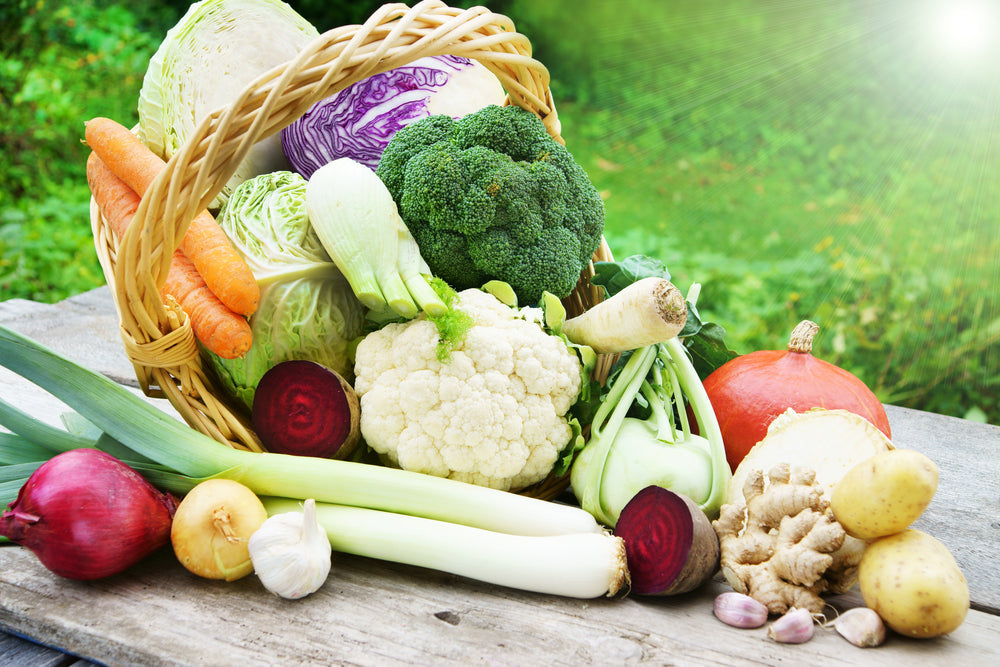Winter is famous for many things - but its harvesting potential isn’t one of them. While it’s true that the colder months pose challenges such as frost and limited daylight, they also offer unique opportunities to grow hardy, resilient vegetables. By selecting the right crops and employing a few clever gardening techniques, you can turn winter into a season of growth and harvest. The experts here at Newton Seeds have created a comprehensive guide that covers everything from garden preparation to catered advice for specific winter vegetables. So, if you're determined to grow vegetables no matter the season, read on for the best winter tips and tricks.
The Best Vegetables to Grow in Winter
Broad Beans
- Varieties: Our Exhibition Longpod seeds are particularly great for sowing over winter.
- Planting Tips: Plant seeds directly into the soil in late autumn. Space seeds 5-10 cm apart in rows 60 cm apart.
- Care Instructions: Support plants with stakes or string to prevent them from falling over. Water regularly but avoid waterlogging.
Garlic
- Best Planting Times: Plant cloves in early winter, spacing them 10cm apart and 20 cm between rows.
- Soil Preparation: Use well-drained soil enriched with Newton’s organic fertilisers.
- Maintenance: Keep the soil moist but not waterlogged. Mulch is ideal for retaining moisture and suppressing weeds.
Cabbage
- Ideal Types for Winter: Savoy, January King, and Red Drumhead.
- Spacing: Space seedlings at least 30 cm apart with 60cm between rows.
- Watering and Pest Control: Water regularly and use organic pest control methods to manage common pests like aphids and cabbage moths.
Celery
- Soil Requirements: Celery thrives in rich, moisture-retentive soil. Consider enriching your soil with KiwiChar.
- Planting Depth: Plant celery in a block spaced around 20 cm apart in each direction.
- Common Issues: Watch for slug and snail damage, especially in wet conditions.
Other Winter Vegetables
- Leeks: Plant in trenches and gradually fill in as plants grow. Harvest in mid-winter.
- Onions: Sow seeds in late autumn. Space seedlings 10cm apart in rows 30cm apart.
- Spinach: Sow seeds directly and thin to 10cm apart. Harvest leaves as needed.
- Silverbeet: Sow each seed about 5cm apart. Thin to 40cm once plants have germinated
- Kale: Sow seeds in late autumn and thin to 45 cm apart. Harvest leaves from the bottom up.
Preparing Your Garden for Winter
Fertiliser
Before you start planting any of your seeds, you first need to get your soil ready. Fortunately, this step is made easy with Newton Seed’s variety of organic fertilisers. Start by clearing out any leftover summer crops and debris. This helps reduce the risk of pests and diseases. Next, give your soil a nutrient boost by sprinkling the fertiliser evenly over your garden bed and mixing it into the top layer of soil. These fertilisers are packed with all the essential nutrients your winter veggies need to thrive.
Mulch
For a little extra TLC you might consider using mulch. Spreading a thick layer of mulch—like straw, leaves, or compost—over your soil will help retain moisture, suppress weeds, and insulate the roots of your plants. For extra frost protection, consider using frost cloths or row covers. These act like mini greenhouses, keeping your plants snug and warm on frosty nights. Just drape them over your garden beds and secure the edges to keep the cold air out.
Crop Rotation
Finally, planning your garden beds and rotating crops is crucial for a healthy garden regardless of the season. Plan your garden by grouping plants with similar needs together and rotating them annually. For example, follow heavy feeders like cabbages with nitrogen-fixing plants like beans. This smart planning not only keeps your soil healthy but also maximises your garden’s productivity.
Caring for Winter Vegetables
Planting Seeds
After your soil is prepped it’s time to plant your seeds. Here you have two main options: sowing seeds directly into the soil or transplanting seedlings. Direct sowing is great for hardy vegetables like broad beans and garlic. Simply plant the seeds at the recommended depth, keep the soil moist, and watch them sprout.
On the other hand, transplanting seedlings can give more delicate plants, like celery, a head start. Start the seeds indoors in small pots and transplant them into your garden once they’re strong enough to handle the cold. This method can help ensure a more robust growth during the winter months.
Watering Methods
Watering your winter garden is all about balance. While your plants still need moisture, the cooler weather means they require less water than in summer. Aim to keep the soil consistently moist but not soggy. Overwatering can lead to root rot and other issues, so it’s important to always check the soil before watering. If it feels damp, hold off. Using a watering can or drip irrigation system can help control the amount of water and direct it to the base of the plants, reducing the risk of fungal diseases.
Pest and Disease Control
Winter might bring fewer pests, but it’s still important to stay vigilant. Common winter pests include slugs, snails, and aphids. To keep these critters at bay, use organic methods like neem oil, and specialised slug products, or if you’re in a pinch, garlic spray works as a good home remedy. Make sure to regularly inspect your plants for signs of pests and diseases, and remove any affected leaves or plants to prevent spread.
Harvesting Tips
After a few months of careful maintenance, you’ll be rewarded with an array of fresh vegetables. Knowing when your veggies are ready to harvest is key to enjoying their flavour and nutritional value. Here are some signs to look for:
- Broad Beans: Pods are full and firm, and beans inside are visible through the pod skin.
- Garlic: Lower leaves turn yellow and start to dry out. The bulbs should be firm and well-formed.
- Cabbage: Heads are firm to the touch and have reached the desired size.
- Celery: Stalks are thick, crisp, and a deep green colour.
- Leeks: Stems are thick and have a firm, white base.
- Onions: Tops fall over and begin to dry out.
- Spinach: Leaves are a vibrant green and have reached a usable size.
- Silverbeet: Stalks are firm, and leaves are large and healthy.
- Kale: Leaves are dark green and firm, and they can be harvested from the bottom up as needed.
We’ve also gathered a few tips to promote continuous production. Following these will ensure that your plants keep producing throughout the season.
- Broad Beans: Pick pods regularly once they are full to encourage more pods to develop.
- Garlic: Lift bulbs carefully with a fork to avoid damage. Leave them to dry in a well-ventilated area before storing.
- Cabbage: Cut the head at the base, leaving the outer leaves and root in place. Sometimes, new smaller heads will form.
- Celery: Harvest stalks from the outside in, allowing the inner stalks to continue growing.
- Leeks: Harvest gradually as needed, starting with the largest ones. This gives smaller leeks more time to grow.
- Onions: Once the tops have fallen over, gently pull up the bulbs and let them cure in a dry, airy spot.
- Spinach: Pick outer leaves regularly to encourage new growth.
- Silverbeet: Harvest outer leaves first, leaving the central growing point intact.
- Kale: Continuously pick the lower leaves, which promotes new growth from the top.
Storage Tips
Once you’ve harvested your vegetables you can use them in a hearty stew, or save them for later. However, if you choose to store your winter vegetables make sure to follow proper protocol to ensure they stay fresh.
First, ensure that your vegetables are clean and dry. Then store them in a cool, dark, and well-ventilated area to prevent spoilage. For leafy greens like spinach, silverbeet, and kale, refrigeration in a plastic bag or wrapped in a damp cloth helps retain moisture and prolong freshness.
Root vegetables and alliums, such as garlic and onions, can benefit from being cured first and then stored in a cool, dry place. Always check stored vegetables regularly and remove any that show signs of spoilage to keep the rest in good condition. By following these general storage tips, you can enjoy the bounty of your winter harvest for an extended period.
Conclusion
If you think you’re ready to start growing this winter, let Newton Seeds get you started on your journey. Whether you're a seasoned gardener or just starting out, now is the perfect time to dive into winter vegetable gardening. Visit our website for fertilisers and seeds, and keep an eye on Newton Seeds’ latest news for ongoing tips, expert advice, and special offers. Let’s make this winter a season of growth and delicious, homegrown produce!

